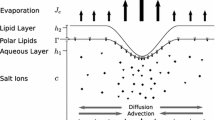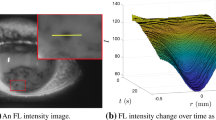Abstract
In this paper, we present a mathematical model describing the effect of polar lipids, excreted by glands in the eyelid and present on the surface of the tear film, on the evolution of a pre-corneal tear film. We aim to explain the interesting experimentally observed phenomenon that the tear film continues to move upward even after the upper eyelid has become stationary. The polar lipid is an insoluble surface species that locally alters the surface tension of the tear film. In the lubrication limit, the model reduces to two coupled non-linear partial differential equations for the film thickness and the concentration of lipid. We solve the system numerically and observe that increasing the concentration of the lipid increases the flow of liquid up the eye. We further exploit the size of the parameters in the problem to explain the initial evolution of the system.
Similar content being viewed by others
References
Berger, R. E., & Corrsin, S. (1974). A surface tension gradient mechanism for driving the pre-corneal tear film after a blink. J. Biomech., 7(3), 225–238.
Braun, R. J., & Fitt, A. D. (2003). Modelling drainage of the precorneal tear film after a blink. Math. Med. Biol., 20(1), 1–28.
Braun, R. J., & King-Smith, P. E. (2007). Model problems for the tear film in a blink cycle: single-equation models. J. Fluid Mech., 586, 465–490.
Breward, C. J. W., Darton, R. C., Howell, P. D., & Ockendon, J. R. (2001). The effect of surfactants on expanding free surfaces. Chem. Eng. Sci., 56, 2867–2878.
Burdon, R. S. (1949). Surface tension and the spreading of liquids. London: Cambridge University Press.
Gipson, I. K. (2004). Distribution of mucins at the ocular surface. Exp. Eye Res., 78, 379–388.
Heryudono, A., Braun, R. J., Driscoll, T. A., Maki, K. L., & Cook, L. P. (2007). Single-equation models for the tear film in a blink cycle: Realistic lid motion. Math. Med. Biol. 24(4), 347–377.
Holly, F. J. (1973). Formation and rupture of the tear film. Exp. Eye Res., 15(5), 515–525.
Illingworth, T. C., & Golosnov, I. O. (2005). Numerical solutions of diffusion-controlled moving boundary problems which conserve solute. J. Comput. Phys., 209, 207–225.
Illingworth, T. C., Golosnov, I. O., Gergely, V., & Clyne, T. W. (2005). Numerical modeling of transient liquid phase bonding and other diffusion controlled phase changes. J. Mater. Sci., 40, 2505–2511.
Jones, M. B., McElwain, D. L. S., Fulford, G. R., Collins, M. J., & Roberts, A. P. (2006). The effect of the lipid layer on tear film behaviour. Bull. Math. Biol., 68(6), 1355–1381.
Jones, M. B., Please, C. P., S McElwain, D. L., Fulford, G. R., Roberts, A. P., & Collins, M. J. (2005). Dynamics of tear film deposition and draining. Math. Med. Biol., 22(3), 265–288.
King-Smith, P. E., Fink, B. A., Nichols, J. J., Nichols, K. K., Braun, R. J., & McFadden, G. B. (2009). The contribution of lipid layer movement to tear film thinning and breakup. Investig. Ophthalmol. Vis. Sci., 50(6), 2747–2756.
Krechetnikov, R., & Homsy, G. M. (2006). Surfactant effects in the Landau-Levich problem. J. Fluid Mech., 559, 429–450.
Lemp, M. A. (2007). The definition and classification of dry eye disease. Ocul. Surf., 5(2), 75–92.
MacDonald, E. A., & Maurice, D. M. (1991). The kinetics of the tear fluid under the lower lid. Exp. Eye Res., 53(4), 421–425.
Maki, K. L., Braun, R. J., Driscoll, T. A., & King-Smith, P. E. (2008). An overset grid method for the study of reflex tearing. Math. Med. Biol., 25(3), 187–214.
Mathers, W. D. (1993). Ocular evaporation in meibomian gland dysfunction and dry eye. Ophthalmology, 100(3), 347–351.
McCulley, J. P., & Shine, W. (1997). A compositional based model for the tear film lipid layer. Trans. Am. Ophthalmol. Soc., 95, 80–93.
Mishima, S., Gasset, A., Klyce, S. D. Jr., & Baum, J. L. (1966). Determination of tear volume and tear flow. Investig. Ophthalmol. Vis. Sci., 5, 264–276.
Nagyova, A., & Tiffany, J. M. (1999). Components responsible for the surface tension of the human tears. Curr. Eye Res., 19(1), 4–11.
Ockendon, H., & Ockendon, J. R. (1995). Viscous flow. Cambridge: Cambridge University Press.
Sakata, E. K., & Berg, J. C. (1969). Surface diffusion in monolayers. Ind. Eng. Chem. Fundam., 8(3), 570–575.
Stone, H. A. (1990). A simple derivation of the time-dependent convective-diffusion equation for surfactant transport along a deforming interface. Phys. Fluids A, 2(1), 111–112.
Tiffany, J. M., Winter, N., & Bliss, G. (1989). Tear film stability and tear surface tension. Curr. Eye Res., 8, 507–515.
Wong, H., Fatt, I., & Radke, C. J. (1996). Deposition and thinning of the human tear film. J. Colloid Interface Sci., 184(1), 44–51.
Author information
Authors and Affiliations
Corresponding author
Rights and permissions
About this article
Cite this article
Aydemir, E., Breward, C.J.W. & Witelski, T.P. The Effect of Polar Lipids on Tear Film Dynamics. Bull Math Biol 73, 1171–1201 (2011). https://doi.org/10.1007/s11538-010-9555-y
Received:
Accepted:
Published:
Issue Date:
DOI: https://doi.org/10.1007/s11538-010-9555-y




